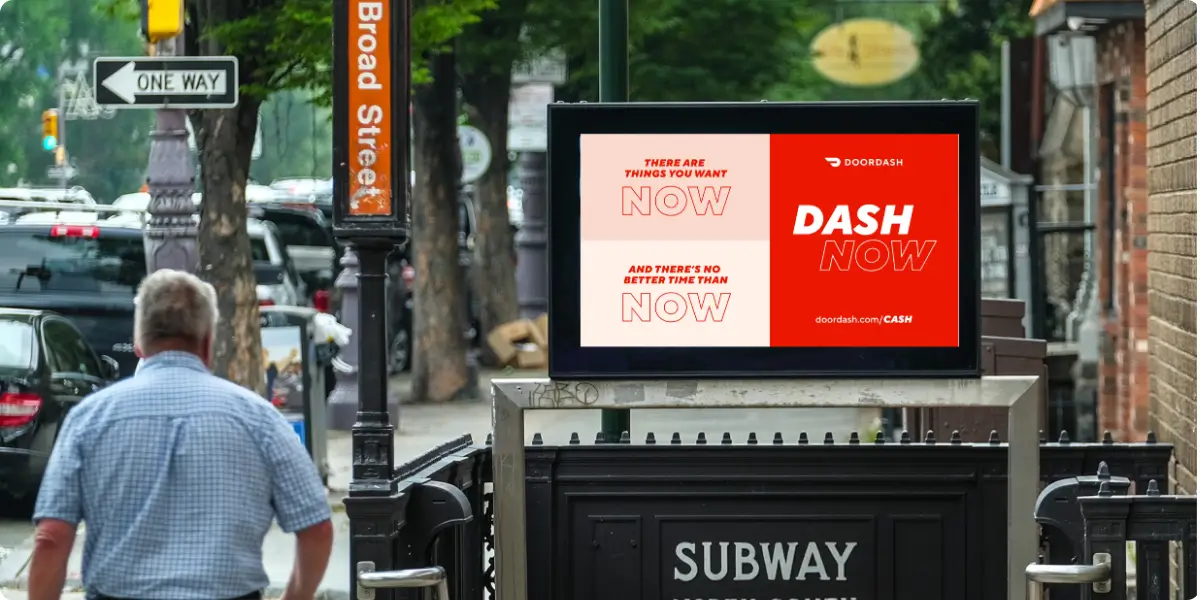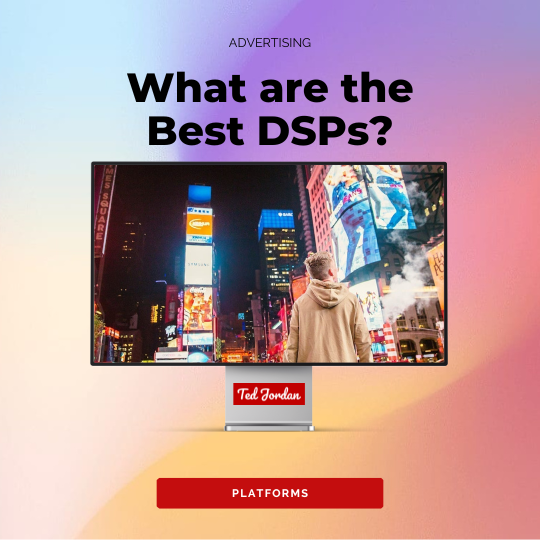If you work in AdTech, in Digital Marketing or if you own a company, you might have encountered the term “DOOH” in some meetings or email threads. But what does DOOH mean and why DOOH formats are so popular?
Today, we explain what DOOH stands for and how it works, using simple terms, so everyone can understand this Programmatic advertising format.
Did you know that, on average, 1/3 of US advertisers have included DOOH in their media plan? So, why wouldn’t you do the same?
(source: VIOOH)

DOOH advertising is growing each year which increases its popularity.
Worldwide DOOH investment should reach USD20.4 bn this year and about 30 bn US dollars by 2029! (source: statista)
Ready to finally understand what DOOH means and how it works?
What does DOOH mean?
DOOH means Digital Out-Of-Home. The term DOOH refers to a Programmatic ad format; that’s why it’s also sometimes called pDOOH or prDOOH (p or pr for Programmatic).
DOOH formats allow advertisers to display their ads on digital screens found in public places such as airports, malls, train stations or streets. Digital Out-Of-Home advertising is also available in specific shops for better targeting. Know that targeting options are endless with Programmatic DOOH!
A CPM pricing model is often used for Digital Out-Of-Home advertising but the CPM corresponds to the average number of people who see an ad per impression (and not the Cost Per Impression).
How to pronounce DOOH?
The right way to pronounce DOOH is “D–O–O–H“. Pronounce each letter, one at the time.
Difference between DOOH and OOH
OOH includes any type of ads outside of your home, that are not on your mobile devices. It’s one of the oldest traditional advertising formats. Think bus shelters, large billboards on the side of the road, poster ads…
DOOH, on the other end, corresponds to the digital version of OOH: ads are displayed on weatherproof digital screens, outside of your home. This way, multiple ads can be displayed from the same advertising space and can be dynamically changed based on various criteria.
Because DOOH is a modern version of OOH advertising, “OOH banners” or “OOH prints” allow sellers and advertisers to differentiate this form of advertising from DOOH.
To change an OOH banner, someone has to do it manually. With DOOH, you can change an ad from your office or schedule one ahead.
Digital Out-Of-Home advertising reduces slow manual processes: you can sell and buy a DOOH ad through Programmatic platforms (Demand-Side Platform or Supply-Side Platform) which makes it easier and quicker for publishers and advertisers to trade.
In 2024, DOOH advertising represented 40% of Out-Of-Home spend vs traditional OOH advertising. Predictions indicate that Digital Out-Of-Home share should increase in the next years.

Digital Out-Of-Home advertising boosts sales with 56% of shoppers purchasing an item featured in a DOOH display.
Source: Yahoo
How DOOH works
Now that you know that the term “DOOH” means Digital Out-Of-Home and corresponds to ads available outside your home, displayed on digital screens, it’s time to explain how DOOH works.
Publishers such as Broadsign or JCDecaux will sell their DOOH inventory directly to you using an advertising sales division or a SSP, or indirectly through a DSP. Before buying their DOOH inventory, you’ll know some information like screen location, CPM, average number of people per impression, ad specs, screen size and loop frequency.
Note that there are pros and cons for each buying method for DOOH advertising. For example, if you buy DOOH ad placements directly from publishers, you will have less control over delivery time or location. But it might be good news for you that you’ll be able to buy DOOH per ad play and to know there are more specific studies done on DOOH with this buying method.
DOOH ad formats can be bought using RTB, Programmatic direct buying or Programmatic Guaranteed (through PMPs or directly). Programmatic Guaranteed (PG) is usually the preferred way of buying DOOH inventory.
We do recommend using a DSP to buy DOOH ads because you’ll be able to manage all your campaigns from the same platform and access premium analytics tools and targeting options. These premium features include retargeting and re-engagement through different DOOH screens and the possibility to buy your DOOH ads using a dynamic CPM.
Is DOOH advertising expensive, you ask?
Well, it depends on a multitude of criteria but here are some CPM pricing examples from Broadsign:
- Los Angeles train station: $5.0
- Los Angeles pharmacy: $6.9
- Chicago gym: $5.6
- New York City billboard: $12.7
Note that Digital Out-Of-Home advertising often requires a minimum investment of $10,000. DOOH screens are not only available in big cities: you can find some screens in elevators or in villages too!

Launching a successful DOOH campaign
Before launching a pDOOH campaign, find the right DSP. We recommend choosing a DSP perfect for DOOH advertising and other cookieless formats like Yahoo DSP or Hawk, which offer very precise information and features. If you are targeting Europe, Adform is another great option!
Once you picked one of the top DSPs for Programmatic advertising, define your campaign goals. Do you want to drive traffic to your store? Are you looking for customers for your new restaurant? Do you want to promote a new offer available in-store? Or maybe you want people to download an app by scanning a QR code?
Then, get familiar with the publisher DOOH ad specs before designing your DOOH ads. Don’t hesitate to include local information such as weather, date, the nearest shop around the location or a QR code (from DOOH to mobile).
One of the most important steps before launching a pDOOH campaign is to set conditions such as targeting options. To do so, make sure to identify your ideal customers and feel free to ask a Programmatic specialist, like Ted Jordan, for help if needed.
Once your campaign is live, measure, analyse and optimise in real time.
Measuring a campaign’s success can be done with drive-to-store measurement, mobile ID information, brand lift study, etc.
To resume, you can launch a successful DOOH campaign by:
- Choosing the right DSP to advertise from.
- Defining your campaign goals and budget.
- Getting familiar with DOOH ad specs before designing your creatives.
- Setting conditions such as targeting options.
- Launching your campaign with the help of a Programmatic specialist if needed.
- Measuring your campaign performance and optimising accordingly in real time.
How to target an audience with DOOH
Targeting the right audience is key to succeed in Programmatic advertising and more precisely here, with pDOOH.
Know that there are plenty of targeting options available through Programmatic Digital Out-Of-Home: gender, age, weather, time of day, day of the week, location, distance around a POI (Point Of Interest), geotargeting and geofencing (with zip codes or DMAs), etc.
For example, you can use live data from airport flight arrival feeds and deliver messages in the right language through DOOH. It’s a great way to advertise some restaurants, activities to do nearby, hotels or ride-hailing services.
Another example of DOOH targeting, for a liquor brand, could be: DOOH screens around bars, clubs and liquor stores, screens in apartment buildings, billboards, 25+, young professionals, ad delivery during bank holiday weekends or after 4 p.m.…
DOOH screen size also plays an important role in your campaign success. Usually, the smaller a screen is, the more precise is the targeting.
There are 3 main DOOH screen types:
- Large screens: for brand awareness, found mainly in high foot-traffic locations (think huge 1920×1080 digital screens or Times Square).
- Medium: contextual targeting and customisation are important (offices, movie theatres, gyms, etc.).
- POP (Point Of Purchase): perfect to boost brand awareness and drive actions to POP by influencing shoppers (gas stations, grocery stores, parking lots).

“84% of those who noticed a brand or product advertised through DOOH are likely to consider it in the future”
Source: MFour Mobile Research + Yahoo
Top benefits of DOOH advertising
Here is a list of the top benefits of Digital Out-Of-Home advertising:
- Ability to quickly change creatives based on various criteria such as weather or time of day.
- High visibility.
- Non-intrusive targeting.
- Flexibility.
- Use of hotspot kiosks in cities to register device IDs from people connecting to the Wi-Fi. More data to analyse for a better targeting and optimisation strategy.
- Possibility to measure the footfall from ads more accurately.
- Access to Programmatic advertising features and inventory from a single platform.
- Possibility to use AR (Augmented Reality) to catch people’s attention at the right time: when a store is open, during a lunch break, when it’s raining, during a game, etc.
- Personalisation: for example, in a supermarket you could display an ad for burgers when a certain number of device IDs (persons) with fast-food apps installed are around.
- Omnichannel strategy.
- Inventory is growing every single day so more screens are available at reasonable prices.
- Use of interactive screens to reinforce interactions between a brand and a consumer.
- Some DOOH screens even have cameras and sensors to collect anonymised data and analyse it to build new audiences.

Before testing DOOH formats
Before launching your first pDOOH campaign, make sure you understand how DSPs work to avoid any bad surprises.
Learn more about DSPs, SSPs and Programmatic advertising in general, by joining our Programmatic Online Course. It’s self-paced, you receive a certificate upon completion, and our Programmatic expert, Ted Jordan, will help you set up your first campaign!
So, what are you waiting for?
New to Programmatic?
If you are just starting in Programmatic Advertising, we recommend that you watch our free Programmatic overview course first. You’ll learn about Programmatic and how to set up a campaign on one of the best DSPs: Yahoo.




